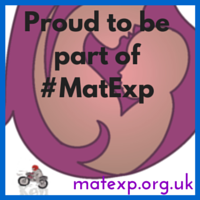I was asked to do a talk to student midwives at Salford University in January on the topic of “Women’s Voices” in maternity care. As part of my presentation I included the voices of the midwives who work in maternity care, and a reminder that there are many other women for whom maternity care is their professional, as well as perhaps their personal, experience. “Women’s Voices” in maternity care should cover the midwives, obstetricians, health visitors, doulas who care for us, as well as the women giving birth.
So I decided to start a series of blog posts on “Women’s Voices in #MatExp” from the point of view of those working in maternity, and this is the sixth of those. This is Carolyn Johnston’s experience as an anaesthetist – thank you so much to Carolyn for agreeing to write for us. You can read the other blogs in the series here:
And yes, I will be doing a “Men’s Voices in #MatExp” series too. Because this campaign is about all voices.
Helen.x
*********************
Carolyn is a consultant anaesthetist in St George’s hospital in London.
Anaesthetics is usually the biggest department of doctors in most hospitals. We cover services including intensive care, operating theatres for all specialties and patient groups, resuscitation teams, pain management, and many other areas as well as maternity care. For those of us with a special interest and training in obstetrics are usually on the maternity unit for the day, but on other days we may be working on general (abdominal) surgery, transplant or any other kind of surgery, intensive care or whatever our other specialty interests may be.
In our unit, my day starts with a handover from the night team. The registrar (senior doctor in training) who has been on the maternity unit overnight tells us who has had anaesthetic input with pain relief (usually epidurals), any women who have been to the operating theatre and require ongoing care and highlighting anyone who may require extra vigilance during the coming day. This might be because of a pre-existing medical issue or developments in labour that may make care more complex. Because all anaesthetists have training that includes caring for people who are critically unwell and are part of resuscitation teams, we have the skills to help the maternity team care for lots of conditions that maternity teams may see very rarely (like heart disease) or those that are more common but might be serious if not treated early (like infection/ sepsis or heavy bleeding).
We also start the day by checking our equipment in the operating theatre and emergency medications. We must be ready to move at a moments notice if the situation arises, for urgent surgery or some other intervention, as we all know, maternity situations can change rapidly! These are scenarios we practice and refine until we can do them as safely as possible. Safety is a key part of anaesthetic practice, in our training we learn a lot about teamwork, safety theories such as ‘human factors’ and communication, and we check and practice a lot, so when we need to act quickly we can do so safely.
We will be involved in any planned (elective) caesarian sections during that day, in my hospital there are usually 2 or 3 cases planned per day. It must be so intimidating for a woman to come to the operating theatre; such a foreign environment and the idea of surgery whilst you are still awake must be so daunting. And then of course the nerves and excitement about finally meeting your baby! I see it as a big part of my job to help make that experience as positive as it can be, and help make women and their partners feel welcome, secure and hopefully even relax. Maybe even some skin-to-skin contact in the theatre.
Maternity work is very different from all other anaesthetic practice because unlike most of our other work, our patients are (usually) awake. This adds to the challenge: undertaking potentially difficult anaesthetic procedures, communicating with the theatre team, maintaining safety by monitoring and reacting to any changes in your patient’s condition but all whilst being mindful that the patient and her partner have holistic needs. Reacting to these needs and helping them to feel safe and secure is very important. There is always a balance to be struck with maintaining our best and usual practice for safety, and providing individualized holistic care. I think this is best achieved by talking and understanding each other’s perspectives. Perhaps we don’t do this enough.
We will, of course, respond to any requests for pain relief for epidurals, which is what most people think of when they think of anaesthetic involvement on delivery suite. It can sometimes be the case that women is distressed, distracted or even scared; so there is a real need for thoughtful communication and co-operation to help her and undertake the epidural safely. This balance of technical and people working skills is a common theme for us in obstetric anaesthetics.
I am lucky that our maternity team values co-operation and team working, and anaesthetists are an important part of that. It isn’t always the case that we are fully included in the team, and this can be a real source of frustration, because so many patients tell us our involvement is very helpful. We have a reputation (unfairly?) of being the epitome of intervention, so I guess we aren’t welcomed by some who hold strong views that birth should be natural. I have no desire to force my interventions on anyone- I would much rather put my feet up! Ultimately, I think the woman can make up her own mind, and as we pride ourselves on knowing the evidence, she should always get impartial advice about risks and benefits from an anaesthetist.
I’ve been trying to avoid the word ‘risk’- I know it’s becoming unpopular in maternity discussions. There is no avoiding it: anaesthetists deal in risk. We train and work in very high-risk areas including emergency surgery, trauma teams, heart surgery, intensive care and in those roles we’ve all seen someone die in front of us as we care for them. Anyone we look after is a patient, and rarely a client- it’s hard to switch this off when we come to maternity and so we often use terminology and even a more risk-based attitude that can clash with the modern ethos of maternity care.
I guess the solution to improving this is to talk more- to all our colleagues in maternity care and to our patients- we all have the same aims and aspirations to provide the best care for healthy happy mums, dads and babies. We also have a reputation for loving coffee, so my suggestion is to grab an anaesthetist on your precious coffee break and ask each other: “why are we all here and what skills do we bring to make that happen?”




